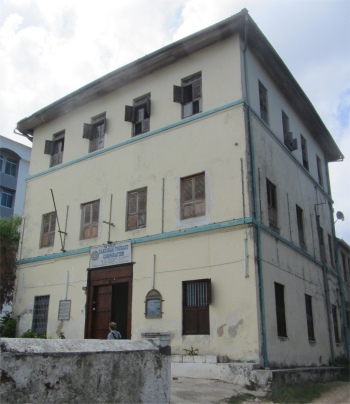 David Livingstone's House |
After a leisurely breakfast on the sunshine roof, Sally trimmed my hair to regulation No. 1 length, and then she went off to pack.
We both travelled off to Barclay's headquarters together, me to recover my bank card, Sally to use the only working ATM. True to form even this ATM was not working now. How unusual. Potential travellers to Zanzibar beware! I was asked to kill time for an hour or so, but I had to return before 1pm, when the office closed.
By coincidence, David Livingstone once lived in the house next door, so we went off to investigate. The house was built around 1860 by Sultan Majid and is located on the northeast side of Stone Town. It was used by Livingstone and other missionaries and explorers such as Burton, Speke, Cameron and Stanley as a starting point for expeditions into eastern and central Africa during the second half of the 19th century. Livingstone lived in this house before departing on his final journey to identify the source of the Nile.
In the early 20th century, the house was used by members of the island's Indian community for a variety of purposes. In 1947, it was bought by the colonial government and became a scientific laboratory for research into clove diseases. After independence and the revolution it became the Zanzibar headquarters of the Tanzania Friendship Tourist Bureau. Today, this old building is now the main office of the Zanzibar Tourist Corporation (ZTC).
Today it was in a dilapidated state, serving the function of Zanzibar Tourism Centre. The interior was basically a shell with one desk for the woman who watched over it during the day; no sign of a Tourism Centre here. She set about boiling a kettle which was sat on the floor in an adjacent room, the only object in the room.
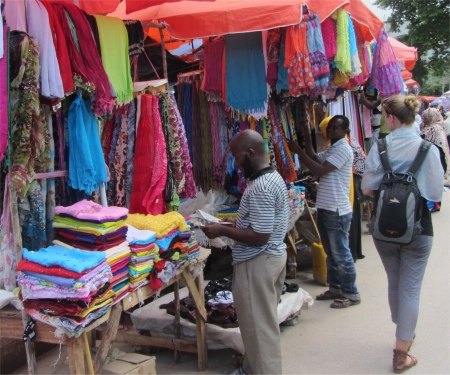 Sally's Textile Inspection behind the Bus Station |
A few sips into my coke and I had a sinking feeling; powerful stuff the coke out here. No, I definitely felt myself slowly sinking into the ground. Because of the angle I was sitting at, I couldn't recover, and I did reach the ground completely. The reason behind all this was the flimsiness of the chair legs, perhaps weakened by the heat, which just slowly crumpled, and that explained why the proprietor had doubled up the chairs. I can't be that heavy, surely? A few minutes later a Zanzibarian joined us on the adjacent table, and repeated my sinking act, much to the mirth of all.
We ambled back to the main office. No, the ATM was still not working, and yes, my card was there. The lady at the till took a photocopy of the card with my passport, and asked me to sign a register. The ledger contained details about my card, plus pages of similar details of other cards from folk of all nationalities. This seemed to be a regular procedure for the bank.
With that thankfully taken care of, we headed off to the textile market behind the bus station and then on to Darajani Market, where Sally bought spices. As we wandered into the maze of alleys in the bazaar behind the market, some colourful textiles caught her attention. Closer inspection of the goods indicated that the young salesman was selling nothing but seconds; all had blemishes on them.
 Fine Example of Stone Town Scaffolding |
We sipped steamy coffee as Sally ploughed through all her internet tasks in hand. In a far corner, a fair-haired German girl sat, oblivious to our presence as she rattled away at her keyboard. Three Zanzibarian men stood at a counter, chatting, totting up receipts, and discussing what was on the screen of a laptop they were using, while a lad served the coffee. Outside it was raining cats and dogs. An eclectic collection of music played out in the background, ranging from "Sultans of Swing" by Dire Straits to "Adagio for Strings" by Barber. Half an hour and more coffee later, the torrent had subsided to just raining, but loud thunder and lightning pervaded the area.
It was then that I noticed a curious thing. The tall building next door was being renovated. A ladder reached up to the roof which I guessed was being tiled. The ladder was being scaled by a young fellow, who clambered onto the roof and proceeded to the apex. Then he casually took out his mobile phone and proceeded to have an animated conversation. Meanwhile lightning bolts were engaged in a pretty dance all around him. Perhaps he had a death wish.
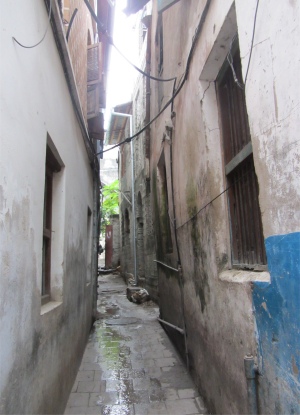 Bazaar Alley |
An elderly Indian chap sat at a keyboard, the glare of the screen painting a garish green hue over his face. "Can we print here?" I asked. "Yes, of course. Tickets?" he enquired; it was probably the most common request he received from travellers. "Yes please," I replied. We agreed on a price, then he fired off instructions in Swahili to his glamorous assistance, an African girl with a dour inclination. She led us into one half of the cell that contained a handful of computers and printers of a vintage that I confined to the tip twenty years ago. We were allocated one of these museum relics, and we waited patiently for the electronic abacus to read Sally's files and print them off.
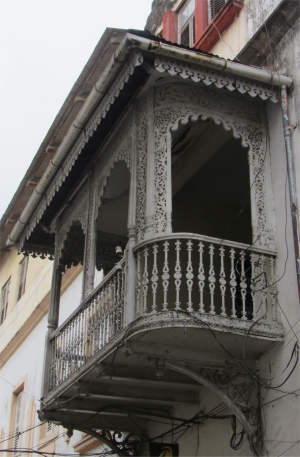 Stone Town Balcony |
Time was creeping on. Sally took me to Livingstone's for one last shared beer and the conclusion to the longstanding Rummy session. A text message arrived from Dan, he was at Dar es Salaam airport, imminently about to depart to Dubai. As we played cards, four sizeable motorised watercraft pulled onto the shore as a flotilla, and very slowly disgorged their passengers. Word had already reached the hawkers, who were out in force with their arms full of colourful shawls and scarfs, T-shirts, sunglasses and nuts. The conveyer belt of humanity slowly proceeded along the beach, whilst an excited group of Zanzibarian children shouted, "Mzungu! Mzungu!" (white people). Not all those alighting from the vessels seemed to be aware of the Muslim dress code (the majority of the island is Muslim). Women with bare shoulders and very short shorts/skirts are severely frowned upon. The throng disappeared en masse into the town.
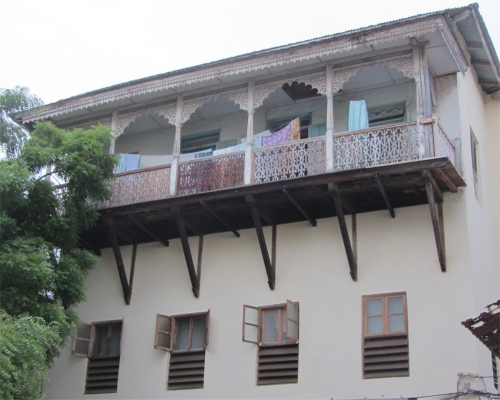 Another Balcony |
Once she was sorted, I walked her down to her cab; she didn't want me to tramp out all the way to the airport with her. One last lingering hug, fond farewells, and she was gone. After an 8pm flight to Nairobi, she would have an all-night wait at the airport before picking up a morning flight out to Kisumu. I had really enjoyed her company over the past 17 days, and had been pleased she had survived unscathed out here over the last few months. Our meeting had been all too short, and now she was gone. Be positive, I thought, she will return to the U.K. in April. And then there was one.
No time for moping, I went off in search of the Hamamni Persian Baths hidden in the dark interior of the bazaar. I eventually found them, but they had already closed for the day. I fell into conversation with a chap in his thirties, who was sitting on a baraza bench outside the baths with his two friends who were more reclined and horizontal. "Are you from the U.K.?" he asked, Crumbs, does it look that obvious? "Yes, I do," I replied. "I lived in Wales," he said with a proud smile beaming from his face. "Really, you haven't got much of a Welsh accent. Iechyd da!", I responded jokingly.
He burst out into fits of laughter, hmm.... it wasn't that funny. "I lived in Pembrokeshire," he continued. "And how long were you there?" I enquired curiously. "Six months. I lived with my Welsh sister-in-law. But it was winter there when I went, very cold it was. My teeth didn't like the cold, and they kept falling out," he replied, and promptly showed me gaps where his upper molars had once stood.
He was a Zanzibarian who had travelled extensively over a two year period. Similar to the old Indian man, this local declared Zanzibar to be the most peaceful place within the continent. Elsewhere he had come across levels of corruption, violence, crime and fear. I knew he could keep me talking here all night long, so I made my excuses and left.
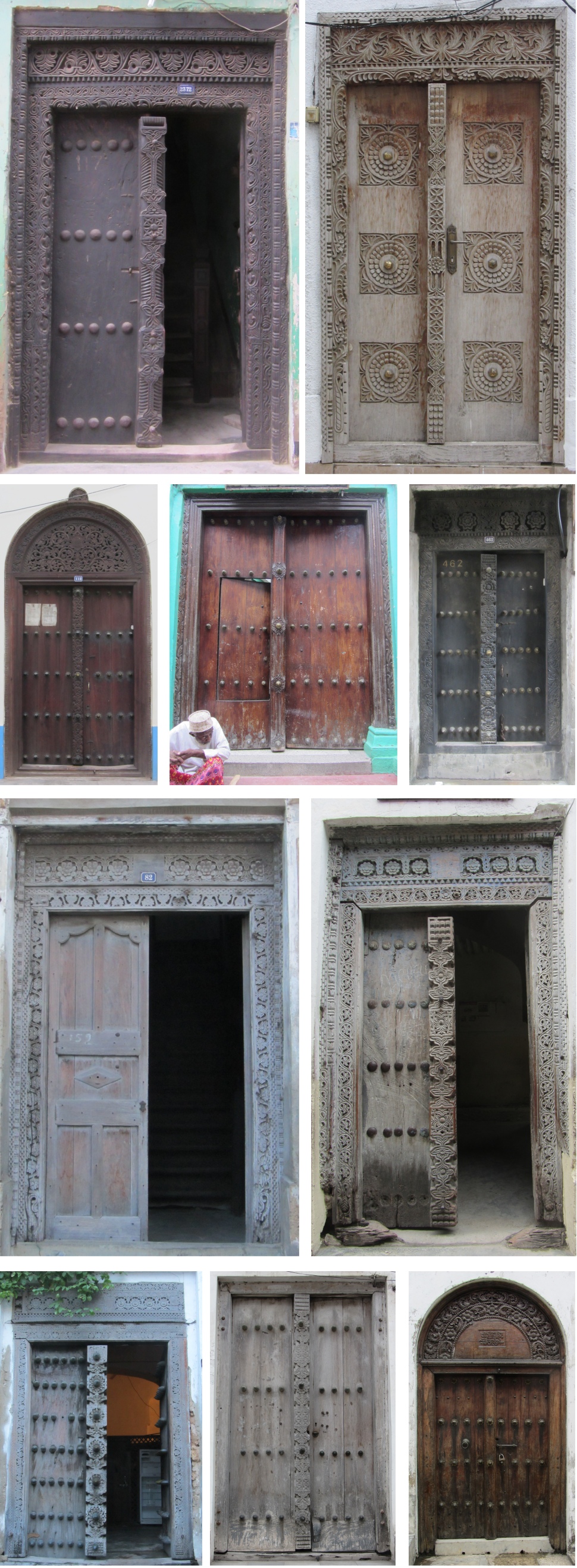 Stone Town Door Examples |
Zanzibar's Stone Town was a city divided into ethnic and economic districts; Arab, Asian, European and Shirazi peoples all lived in relatively distinct pockets of Stone Town. Each of these peoples usually specialised in a certain trade, and the different trades were concentrated together into business districts; quite apparent when you notice that similar doors are found together in groups.
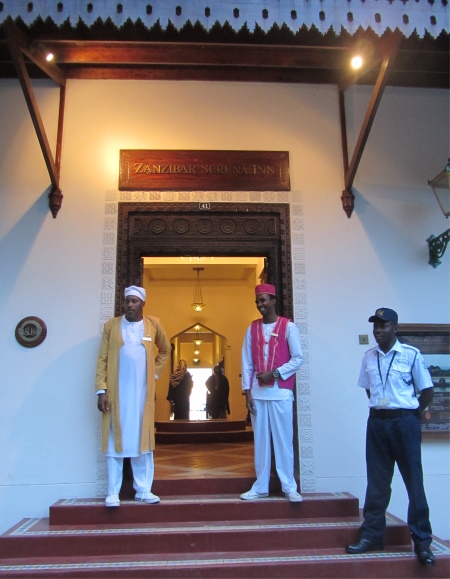 Zanzibar Serena Inn, a Bit Upmarket from Flamingos Hostel |
The second type are "Arab doors". The older Arabic doors are almost always rectangular in shape and often contain Koranic script on the lintel, and are richly decorated around the frame. As slave trading was an almost exclusively Arabic trade, chains are featured on these doors more than any other. Meanwhile, geometric patterns indicate Arab merchants who acted as accountants for other traders in Stone Town. The semi-circular frames were introduced later, but are still referred to as "Arab doors".
Symbolic designs were a feature on Zanzibari doors. Flowers represented a family, pineapples were a sign of welcome, rope was commonly seen to symbolise security, vines indicated the owner dealt in the spice trade, frankincense and date palms symbolised wealth and plenty, and chains gave a clear indication that the owner both possessed and traded slaves.
As the sun sank beyond the horizon, I watched a gang of lads take run and jumps off the sea wall by Forodhani Gardens. They were summersaulting, belly flopping and just plain showing off as they hit the water at speed from a height. What concerned me was the ebb of the tide, and the little margin for error in the water as it grew shallower. Foolhardy bravado.
In the evening I dined almost at rooftop level, and watched as a silent set of blinking lights slowly passed over the sea. It was shortly after 8pm, and it must have been Sally on her way to Nairobi.
Once fed, I returned to our old haunt, Livingstone's, for one last evening beer by the lapping sea. The music was more subdued than the previous night, and I could hear the waves gently kissing the shore and the distant throb of ship's engines. Far away on the horizon, lightning silently lit up the sky. A small piece of paradise.
The dream was shattered when I returned to Flamingos. About 60m away from the hostel an Indian wedding celebration was in full swing. It stopped, or I thought it had, at midnight, and then after a 10 minute break, burst into life again. Argh!..... I just want sleep.
 Prison Island |
